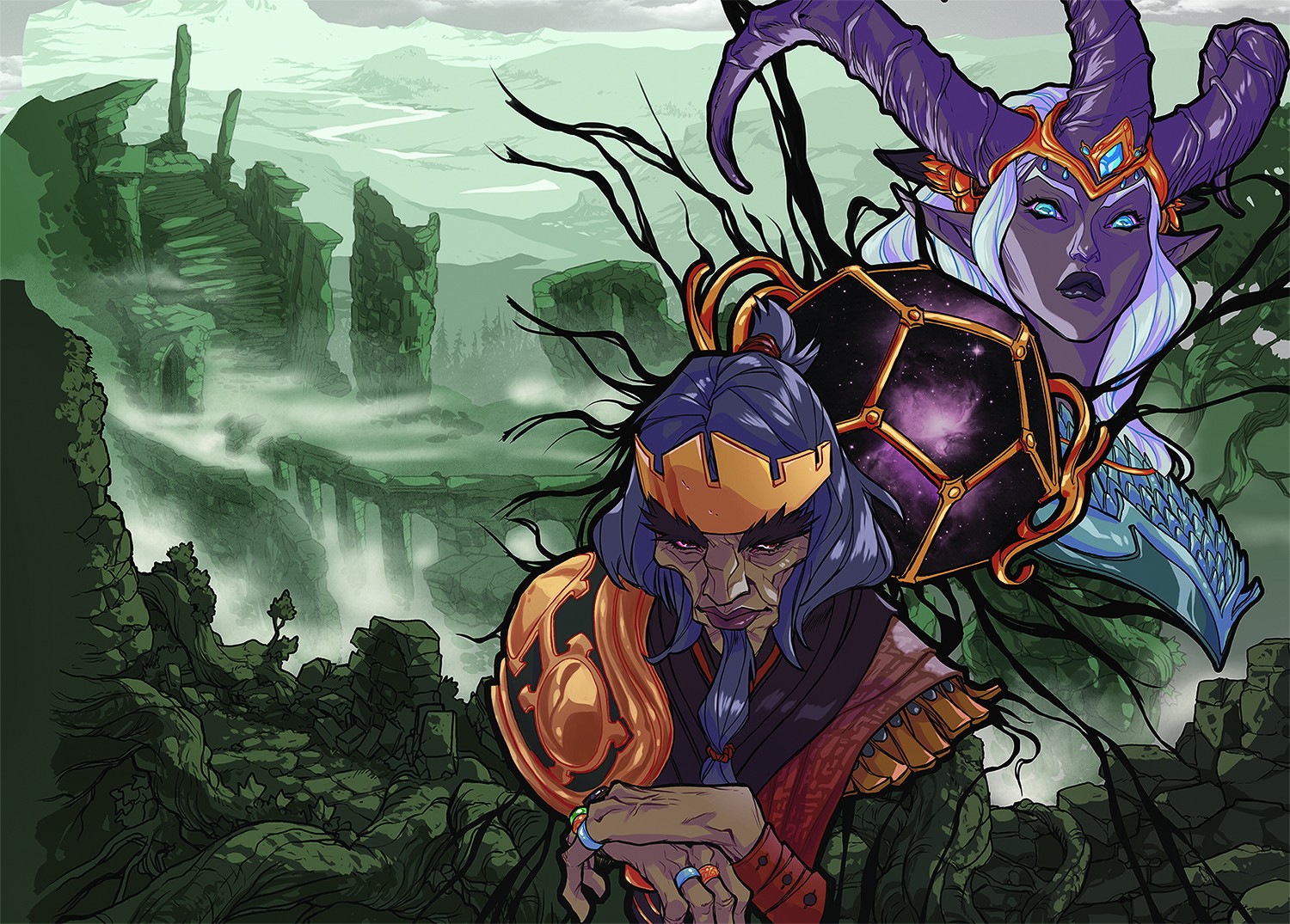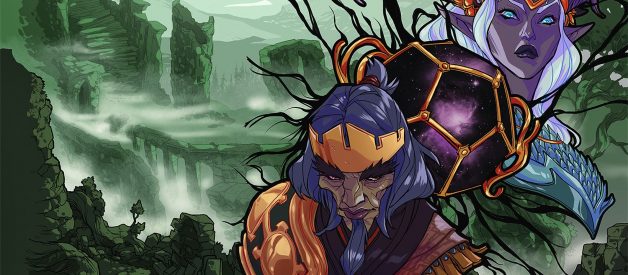Whether it be D&D or Pathfinder, a Game Master Can Turn a Great Game Into a Horror Show
 Explorer?s Guide to Wildemount
Explorer?s Guide to Wildemount
The Dungeon Master has one of the hardest jobs in gaming. Not only must they be the interpreter of the rules, the roleplayer behind a cast of non-player characters, and oftentimes the story creator behind a homebrew adventure, they must also be the Law when it comes to final decisions, the Helping Hand when it comes to really bad dice rolling and the Kindly Sage when it comes to introducing new players to the game.
At times, it can be thankless. Or, at least, not thanks enough.
Too often, players don?t understand exactly how much hard works goes into being a good dungeon master. They come to the game table prepared by bringing their character sheet and perhaps a copy of the player?s handbook. The DM comes to the table prepared by doing hours upon hours of work either studying the pre-made adventure or spending even more hours creating their own.
But let?s face it, not everyone is cut out to be a great dungeon master. While most can end up being pretty good with practice, some might need a drastic personality change before they would ever be good at running a table.
So let?s look at some of these bad traits.
1. The Adversarial Dungeon Master
This is where the difference between challenge and competition is key. The idea that any wrong move, fight or trap might ultimately end in the death of your character creates an excited tension in the game, but the idea that the Dungeon Master is ?out to get? the players is a recipe for disaster.
Dungeon mastering is hard, especially for the DM that creates their own stories. The DM really is designing areas with the intent of hurting and possibly killing the players, but they are also ensuring they can succeed. And the best DMs are always rooting for the players.
An adversarial relationship between dungeon master and players can take on many different forms. The ?I am the God of the story? complex can be counterproductive in a game centered around the idea of a shared interactive story. The ?NPCs have all the fun? creates players that rightfully feel as if their characters are minor accompaniments to the dungeon master?s story when they should e the main attraction. And the ?I am trying my best to kill you? DM might find it too easy to cross the line.
2. The Balance of Saying No
Would-be dungeon masters only need look to the philosophy of improvisation as a guiding light. Improv teaches to say ?Yes, and?? rather than ?No.? And a good dungeon master always tries to start with ?Yes, and??
This includes allowing players to go off-path. Few players love a completely railroaded story that can only go in one direction. The beauty of a good pen and paper roleplaying game lies in its freedom of choice.
No matter how crazy or absurd, the good dungeon master should always be looking for a way to say ?Yes, and??
The key to this philosophy is that the ?And?? can essentially be used to turn the player?s request into a No if need be. The first level characters want to explore the forest instead of staying on the path? Perhaps they run into an Ogre who chases them back to the road. (And remember: Players will surprise you, and sometimes this means they stay to fight that overly powerful monster that is supposed to be a stop sign.)
But the essence of this philosophy is to allow the players to go off script and try your best to accommodate them. Rather than setting up a lot of stop signs and u-turns, bring along maps that allow you to play out an on-the-spot adventure if need be.
And while ?Yes, and?? is a great tool, the dungeon master does need to balance it by sometimes simply saying no. That player that thinks their 16 strength character can lift a 2,000 pound boulder over their head? That?s not a time for ?Okay, we?ll see if you can roll a natural 20??
Remember, a natural 20 is a 5% chance. So a ?roll for a 20? should only be applied in instances where the character has about a 5% chance of doing it. Shoot an arrow in a goblins eye from 60 yards? Sure, 5% chance. Throw a hatchet and fell a tree with a 5 feet radius? Not a chance.
It?s the balance between always trying to work with the players while keeping actions reasonable that can sometimes be a hard line to walk. If you have a dungeon master that is always slamming the door of No against all ideas, you are probably working with a bad DM. But if your players can try almost anything, the game suffers.
3. The DM Who Plays Favorites/Unfavorites
Perhaps you?ve been there. The one unruly player that brings the fun level way down for the entire party, but they happen to be the DM?s best friend so they get cut all the slack. Or every time the DM doesn?t like an idea, that player?s character seems to suffer. Or one special person in the group always gets the great loot. Or perhaps worst of all, the player without a penis always seems to be roped into playing the healer.
Above all else, the dungeon master must be impartial and fair. Or, at least, random. And it is with randomness that I always liked to solve most of the problems. Who stepped on the arrow trap? Roll a dice. Who does the black dragon choose to spit acid at? Roll the dice. Who does the avatar give that special item to? Roll the dice.
When the DM is clearly playing favorites or picking on a specific player in the group, it easily ruins the fun for everyone.
4. The Dungeon Master Who Doesn?t Control the Room
This one counts for both actions both inside and outside of the game. The easy example is out-of-character metagaming, but also covers things such as allowing a single character to sidetrack an entire adventure with absurd theatrics such as randomly stabbing innocent villagers in town.
As a DM, there are times when you want to sit back and let the chaos you?ve created reign. But there is a difference between allowing character to play their part in a heated discussion and allowing squabbling to eclipse the role-playing side of the dynamic.
And while some players may get off on in-character disruptions ? which is perfectly fine to a point ? the good dungeon master should also ensure there is some law and order. Want to randomly kill innocents? Unfortunately, the hedge wizard in town to buy ingredients magically contacted an enchanted police force?
5. The DM Unwilling to Learn/Change
This may very well be the biggest sign of a bad dungeon master. Hey, all of us are learning. There are many people that love being the dungeon master for multiple reasons. And then there are dungeon masters that feel ?forced? into it because no one else wants to do the job. Not matter, the primary guiding light of pen and paper roleplaying is for it to be fun. Period.
So if the group of players bring up issues with the dungeon master, whether it be ?We think it?s too combat-focused? or ?We spend too much time going over backstory? or ?You never let us wander off into the forest? or ?Chuck is always bringing the whole group down with his rules lawyering? or whatever it might be, the good dungeon master listens and adjusts.
If your dungeon master refuses to listen to your requests, you may have a bad dungeon master.
Is It Possible to Play a Tabletop RPG Without a Game Master?
In a word, yes.
I?ve written about playing D&D or Pathfinder alone or without a dungeon master. And I?ve heard a lot of the ?oh no, it?s definitely a game that requires?? arguments. And they generally stink.
A common occurrence is a group of people who want to play but no one wants to be the dungeon master. And there is an easy solution to this one: share the duties. Take turns with who is being the dungeon master. It might be harder to go through an official campaign this way, but the best part of any RPG is making up your own stories.
A group can treat it similar to the old Continue the Story game. One person starts, and after they?ve told a bit of the story, the next person continues by either taking it to its logical next destination or throwing everyone for a loop. This is a great way to share the duties and can take some of the stress off the table.
The chosen dungeon masters can look to random map generators to help with some of the heavy lifting, purchase map packs from online stores like Dungeon Master?s Guild, or draw their own maps on graph paper. If you don?t know where to go with a story, there are even random adventure tables you can use on Donjon to kickstart some ideas.
You can even rotate who DMs combat with each encounter. That way, even the person who came up with the story and/or created the map can have fun throwing down cans of whoop ass.
Playing alone? This is a bit harder. Even with two people, the task isn?t monumental, but playing completely alone definitely takes some imagination. But believe it or not, there are solo modules out there. The random map generator I created was created for players to explore through a fog-of-war, but even without software, you can explore dungeons by using the random dungeon tables at the back of the DM?s Guide. And using the adventure tables on Donjon, you can let your imagination take over and create your own adventure in your head.
The number one rule for roleplaying games: have fun. You can have a blast playing D&D, Pathfinder or almost any other RPG alone. And if you have a small group with no DM, you shouldn?t let that stop you!
Daniel developed Endless RPG for players who didn?t have a DM or Dungeon Masters who wanted help putting together campaigns. The Endless RPG app creates random dungeons (crypts, ruins, caves, etc.) and populates them with monsters, traps, treasures and events. You can download Endless RPG on the Steam store for PC. It is also available on Apple?s App Store for the iPhone and iPad and on Google Play for Android devices.


